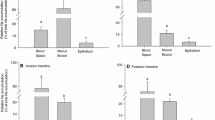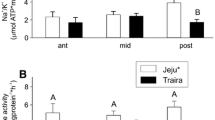Abstract
InLymnaea stagnalis, oral uptake of ambient medium was studied using51Cr-ethylenediaminetetra-acetic acid. In normal snails Cr-ethylenediaminetetra-acetic acid uptake showed two components: a high uptake rate within the first hour followed by moderate uptake proportional with time. The tracer accumulated mainly in the digestive system. All animals showed initial, transient uptake. Moderate uptake proportional with time did not occur in snails in which the buccal ganglia had been extirpated, in which both the buccal ganglia had been extirpated and the oesophagus was sectioned, or in snails provided with an oesophageal fistula. These snails did not accumulate tracer in the intestinal system. This type of tracer accumulation clearly represented oral ingestion of surrounding water. The oral water ingestion rate ranged from 8 to 12 μl·h−1·g−1. Assuming complete absorption, this accounts for 20–30% of the urine production rate. At low external concentrations the contribution of oral water ingestion to Na+ balance is negligible. However, its importance will grow with increasing external concentrations and becomes a major factor at higher concentrations. The ingestion rate increased almost sixfold when starving snails were allowed to feed. It is suggested that oral water ingestion is a consequence of making bite cycles and swallowing.
Similar content being viewed by others
Abbreviations
- cpm :
-
count per minute
- EDTA :
-
ethylenediaminetetraacetic acid
References
Aardt WJ van (1968) Quantitative aspects of the water balance inLymnaea stagnalis (L.) Neth J Zool 18: 253–312
Boer HH, Kits KS (1990) Histochemical and ultrastructural study of the alimentary tract of the freshwater snailLymnaea stagnalis. J Morphol 205: 97–111
Boer HH, Montagne-Wajer C, Smith FG, Parish DC, Ramkema MD, Hoek RM, Minnen J van, Benjamin PR (1994) Functional morphology of the light yellow cell and yellow cell (sodium influx-stimulating peptide) neuroendocrine system of the pond snailLymnaea stagnalis. Cell Tissue Res 275: 361–368
Carroll S, Hazon N, Eddy FB (1995) Drinking rates and Na+ effluxes in response to temperature change in two species of marine flatfish: dab,Limanda limanda and plaice,Pleuronectus platessa. J Comp Physiol B 164: 579–584
Deyrup-Olsen I, Martin AW (1987) Osmolyte processing in the gut and an important role of the rectum in the land slug,Ariolimax columbianus (Pulmonata: Arionidae). J Exp Zool 243: 33–38
Dixon WD, Massey FJ (1969) Introduction to statistical analysis. McGraw-Hill, New York
Duivenboden YA van (1982) Non-ocular photoreceptors and photo-orientation in the pond snailLymnaea stagnalis (L.). J Comp Physiol 149: 363–368
Greenaway P (1970) Sodium regulation in the freshwater molluscLimnaea stagnalis (L.). (Gastropoda: Pulmonata). J Exp Biol 53: 147–163
Greenaway P (1971a) Calcium regulation in the freshwater molluscLimnaea stagnalis (Gastropoda: Pulmonata). I. The effect of internal and external calcium concentration. J Exp Biol 54: 199–215
Greenaway P (1971b) Calcium regulation in the freshwater molluscLimnaea stagnalis (Gastropoda: Pulmonata). II. Calcium movements between internal calcium compartments. J Exp Biol 54: 609–620
Jager JC (1971) A quantitative study of a chemoresponse to sugars inLymnaea stagnalis (L.). Neth J Zool 21: 1–59
Kuhlmann D, Feiden F (1976) Untersuchungen zur homöostatischen Regulation der Osmolalität der Hämolymphe vonLymnaea stagnalis L. (Gastropoda, Basommatophora). Zool Jb Physiol 80: 82–100
Lever J, Bekius R (1965) On the presence of an external haemal pore inLymnaea stagnalis. Experientia 21: 395–396
Luchtel DI, Martin AW, Deyrup-Olsen I (1984) The channel cell of the terrestrial slugAriolimax columbianus (Stylommatophora, Arionidae). Cell Tissue Res 235: 143–151
Neuckel W (1985) Anal water uptake in terrestrial pulmonate snails. J Comp Physiol B 156: 291–296
Prior DJ (1984) Analysis of contact-rehydration in terrestrial gastropods: osmotic control of drinking behaviour. J Exp Biol 111: 63–73
Prior DJ (1985) Water-regulatory behaviour in terrestrial gastropods. Biol Res 60: 403–424
Shaw J (1956) The absorption of sodium ions by the crayfishAstacus pallipes (Lereboullet). I. The effect of external and internal concentrations. J Exp Biol 36: 126–144
Smit AB, Thijsen SFT, Gerearts WPM (1993) cDNA cloning of the sodium influx stimulating peptide in the mollusc,Lymnaea stagnalis. Eur J Biochem 215: 397–400
Steen WJ van der, Hoven NP van der, Jager JC (1969) A method for breeding and studying freshwater snails under continuous water change, with some remarks on growth and reproduction inLymnaea stagnalis (L.). Neth J Zool 19: 131–139
Uglem GL, Prior DJ, Hess SD (1985) Paracellular water uptake and molecular sieving by the foot epithelium of terrestrial slugs. J Comp Physiol B 156: 285–289
Wendelaar-Bonga SE, Boer HH (1968) Ultrastructure of the renopericardial system in the pond snailLymnaea stagnalis (L.). Z Zellforsch 94: 513–529
With ND de (1977) Evidence for the independent regulation of specific ions in the haemolymph ofLymnaea stagnalis (L.) Proc Kon Ned Akad Wet C 80: 144–157
With ND de (1978) The effects of starvation and feeding on the ionic composition of the haemolymph in the freshwater snailLymnaea stagnalis. Proc Kon Ned Akad Wet C 81: 241–249
With ND de (1979) The use of a new cannulation technique and of125I-labelled iothalamate for the study of the renal filtration rate in the freshwater snailLymnaea stagnalis. Proc Kon Ned Akad Wet C 82: 401–407
With ND de (1980) Water turn-over, ultrafiltration, renal water reabsorption and renal circulation in fed and starved specimens ofLymnaea stagnalis, adapted to different external osmolarities. Proc Kon Ned Akad Wet C 83: 109–120
With ND de, Berg HA van den (1992) Neuroendocrine control of hydromineral metabolism in molluscs, with special emphasis on the pulmonate freshwater snail,Lymnaea stagnalis. Adv Comp Endocrinol 1: 83–99
With ND de, Schors RC van der (1982) On the interrelations of the Na+-and Cl−-influxes in the pulmonate freshwater snailLymnaea stagnalis. J Comp Physiol 148: 131–135
With ND de, Schors RC van der (1984) Urine composition and kidney function in the pulmonate freshwater snailLymnaea stagnalis. Comp Biochem Physiol 79A: 99–103
With ND de, Kok TP, Schors RC van der (1987) Relationship between apparent net H+ excretion and Na+, Ca2+, and Cl− uptake in the pulmonate freshwater snailLymnaea stagnalis. Comp Biochem Physiol 87A: 671–675
With ND de, Schors RC van der, Boer HH, Ebberink RHM (1993) The sodium influx stimulating peptide of the pulmonate freshwater snailLymnaea stagnalis. Peptides 14: 783–789
With ND de, Slootstra JW, Schors RC van der (1988) The bioelectrical activity of the body wall of the pulmonate freshwater snailLymnaea stagnalis: effects of neurotransmitters and the sodium influx stimulating neuropeptides. Gen Comp Endocrinol 70: 216–223
Zijlstra U (1972a) Histochemistry and ultrastructure of the epidermis and the subepidermal gland cells of the freshwater snailLymnaea stagnalis andBiomphalaria pfeifferi. Z Zellforsch 130: 93–124
Zijlstra U (1972b) Uptake of particulate matter by the epidermis of the freshwater snailLymnaea stagnalis. Neth J Zool 22: 299–306
Author information
Authors and Affiliations
Additional information
Communicated by H. Huddart
Rights and permissions
About this article
Cite this article
De With, N.D. Oral water ingestion in the pulmonate freshwater snail,Lymnaea stagnalis . J Comp Physiol B 166, 337–343 (1996). https://doi.org/10.1007/BF02439921
Accepted:
Issue Date:
DOI: https://doi.org/10.1007/BF02439921




